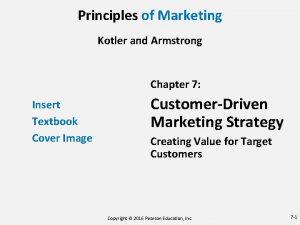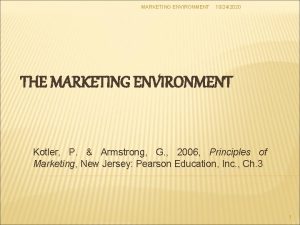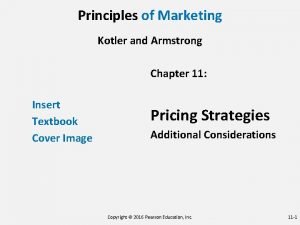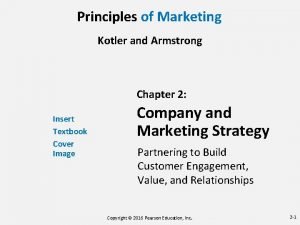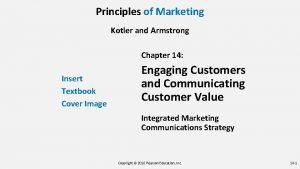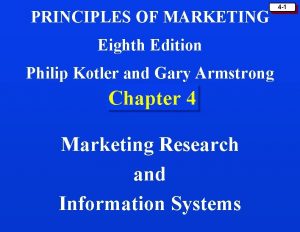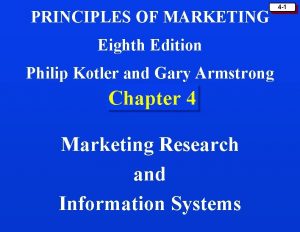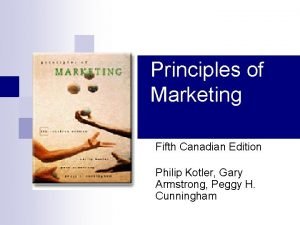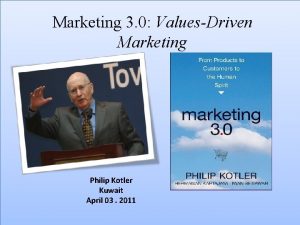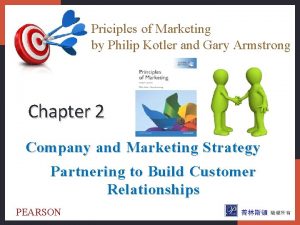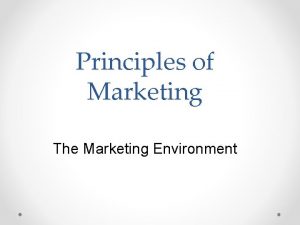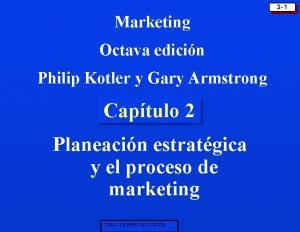2 1 PRINCIPLES OF MARKETING Philip Kotler and
















- Slides: 16

2 - 1 PRINCIPLES OF MARKETING Philip Kotler and Gary Armstrong Chapter 2 Strategic Planning and the Marketing Process Ó Copyright 1999 Prentice Hall

Strategic Planning Process 2 - 2 • Strategic Planning involves developing an overall company strategy for long-run survival and growth. • This process involves: – Defining a Mission: Statement of an organization’s purpose; should be market oriented. – Setting Company Objectives: Supporting goals and objectives to guide the entire company. – Designing a Business Portfolio: Collection of businesses and products that make up the company. – Planning Functional Strategies: Detailed planning for each department designed to accomplish strategic objectives. Ó Copyright 1999 Prentice Hall

2 - 3 Ó Copyright 1999 Prentice Hall

Designing the Business Portfolio 2 - 4 • The best portfolio is the one that best fits the company’s strengths and weaknesses to the opportunities in the environment. • The company must: – analyze its current business portfolio or Strategic Business Units (SBU’s) – decide which SBU’s should receive more, less, or no investment – develop growth strategies for adding new products or businesses to the portfolio Ó Copyright 1999 Prentice Hall

Analyzing Current SBU’s: Boston Consulting Group Approach Low High Market Growth Rate Relative Market Share High Stars Low Question Marks • High growth & share • Profit potential • May need heavy investment to grow Cash Cows • High growth, low share • Build into Stars/ phase out • Requires cash to hold market share Dogs • Low growth, high share • Low growth & share • Established, successful • Low profit potential SBU’s • Produces cash Ó Copyright 1999 Prentice Hall 2 - 5

Analyzing Current SBU’s: GE Strategic Business-Planning Grid Industry Attractiveness Business Strength Strong Average High Weak C A Medium B Low Ó Copyright 1999 Prentice Hall D 2 - 6

Developing Growth Strategies Product/ Market Expansion Grid Existing Products Existing Markets 1. Market Penetration New Markets 2. Market Development New Products 3. Product Development 4. Diversification Ó Copyright 1999 Prentice Hall 2 - 7

Product/ Market Expansion Grid 2 - 8 • Market Penetration: Penetration increase sales to present customers with current products. How? Cut prices, increase advertising, get products into more stores. • Market Development: Development develop new markets with current products. How? Identify new demographic or geographic markets. • Product Development: Development offering modified or new products to current customers. How? New styles, flavors, colors, or modified products. • Diversification: Diversification new products for new markets. How? Start up or buy new businesses. Ó Copyright 1999 Prentice Hall

Marketing’s Role in Strategic Planning 2 - 9 • Process of Selecting Target Consumers – Market Segmentation: Segmentation determining distinct groups of buyers (segments) with different needs. – Market Targeting: Targeting evaluating and selecting which target segments to enter. – Market Positioning: Positioning products distinctive and desirable place in the minds of target segments compared to competing products. • Marketing Strategies for Competitive Advantage – Market-Leader – Market Challenger – Market-Follower – Market-Nicher Ó Copyright 1999 Prentice Hall

2 - 10 The Marketing Process Demographic. Economic Environment M A ark na e ly tin si g s Target Place Consumers Price Promotion Competitors Ó Copyright 1999 Prentice Hall Publics Im Ma pl rk em et en ing ta tio n g tin ke ol ar tr M Con Political. Legal Environment Product g tin g ke in ar n M lan P Suppliers Technological. Natural Environment Marketing Intermediaries Social. Cultural Environment

Marketing Mix- The Four P’s 2 - 11 Price Product “Goods-and-service” combination that a company offers a target market Amount of money that consumers have to pay to obtain the product Target Customers Intended Positioning Activities that persuade target customers to buy the product Promotion Company activities that make the product available Ó Copyright 1999 Prentice Hall Place

Managing the Marketing Effort 2 - 12 Marketing Analysis of Company’s Situation Marketing Planning Develop Marketing Strategies to Achieve Marketing Objectives Develop Marketing Plans & Budget Marketing Implementation Turn Marketing Plans into Action Plans to Achieve Marketing Objectives Ó Copyright 1999 Prentice Hall Control Measure Results Evaluate Results Take Corrective Action

Elements of a Marketing Plan Executive Summary Current Marketing Situation Threats and Opportunities Objectives and Issues Marketing Strategy Action Programs Budgets Controls Ó Copyright 1999 Prentice Hall 2 - 13

2 - 14 Marketing Implementation Marketing Strategy Decision and Reward Organizational Structure Action Programs Human Resources Climate and Culture Implementation Marketing Performance Ó Copyright 1999 Prentice Hall

Marketing Control Set Marketing Goals Measure Performance Evaluate Performance Take Corrective Action Ó Copyright 1999 Prentice Hall 2 - 15

Marketing Audits 2 - 16 Environment Function Productivity Types of Marketing Audits Systems Ó Copyright 1999 Prentice Hall Strategy Organization
 Principles of marketing by philip kotler
Principles of marketing by philip kotler Principles of marketing philip kotler ppt
Principles of marketing philip kotler ppt Marketing management (arab world edition) philip kotler
Marketing management (arab world edition) philip kotler Marketing management (arab world edition) philip kotler
Marketing management (arab world edition) philip kotler Marketing management (arab world edition) philip kotler
Marketing management (arab world edition) philip kotler Marketing management (arab world edition) philip kotler
Marketing management (arab world edition) philip kotler Kotler’s environment model
Kotler’s environment model Father of traditional marketing
Father of traditional marketing Marketing management (arab world edition) philip kotler
Marketing management (arab world edition) philip kotler Marketing management (arab world edition) philip kotler
Marketing management (arab world edition) philip kotler Kotler armstrong marketing
Kotler armstrong marketing Marketing chapter 11
Marketing chapter 11 Philip kotler
Philip kotler New market realities
New market realities Marketing chapter 2
Marketing chapter 2 Kotler et al 2017
Kotler et al 2017 Integrated marketing communication ppt kotler
Integrated marketing communication ppt kotler

